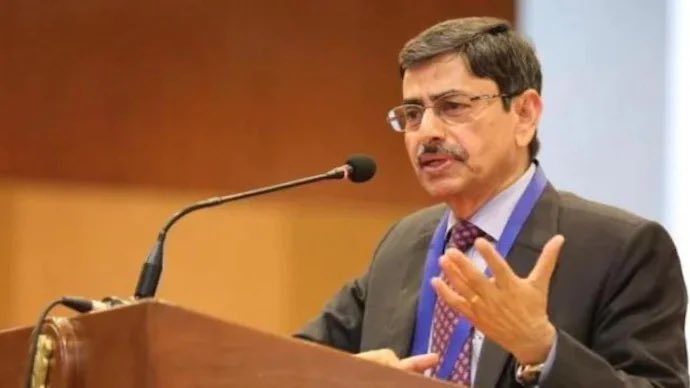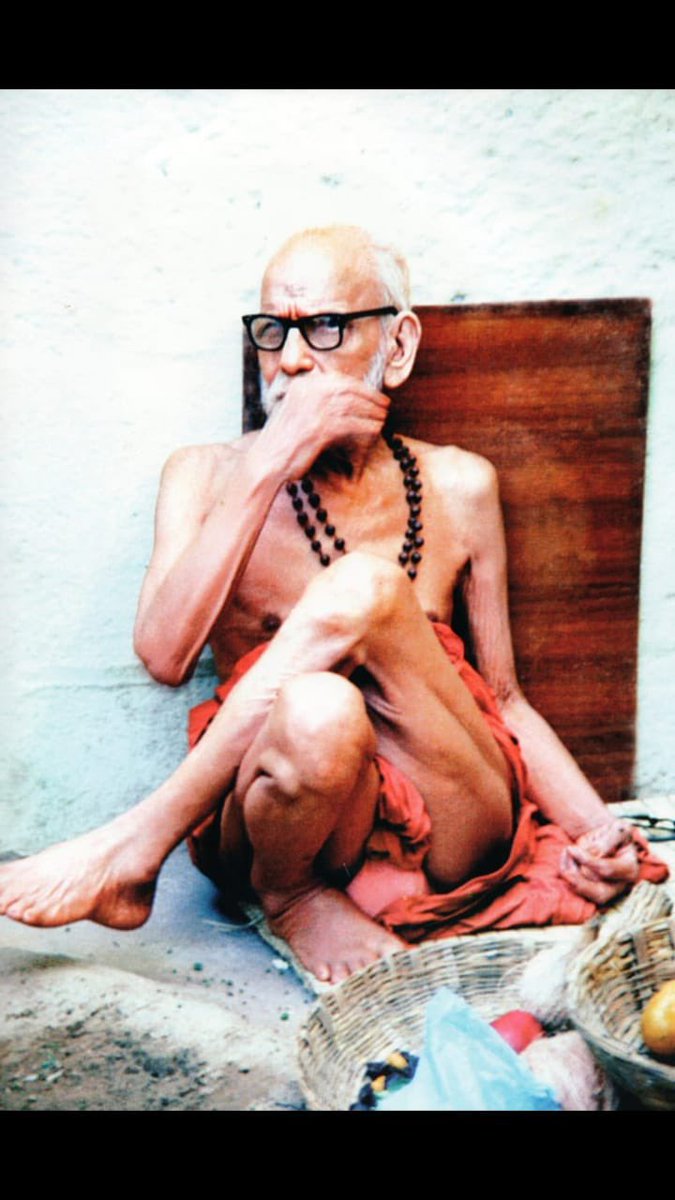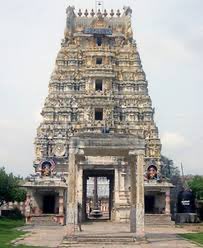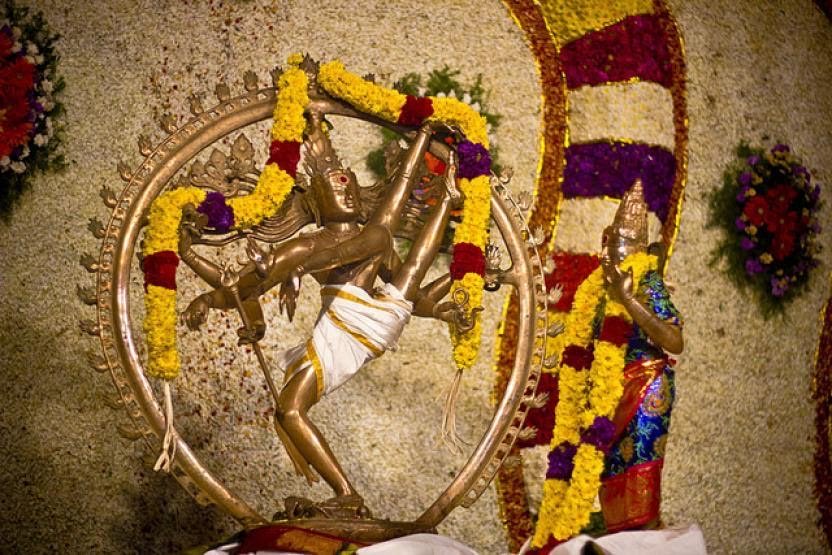
#MagaPeriyava
Kanchi Saint Attains Maha Samadhi- News Article published in the Quarterly Journal #Hinduism_Today in March 1994.
His Holiness, Sri Chandrasekharendra Saraswathi, the Shankaracharya of Kanchi Kamakoti Peetam in South India, passed away in Kanchipuram, Tamil Nadu,
Kanchi Saint Attains Maha Samadhi- News Article published in the Quarterly Journal #Hinduism_Today in March 1994.
His Holiness, Sri Chandrasekharendra Saraswathi, the Shankaracharya of Kanchi Kamakoti Peetam in South India, passed away in Kanchipuram, Tamil Nadu,

on Saturday, January 8th, 1994, just four months before he was due to complete his centenary. The end of the 68th pontiff of the Kanchi Mutt came suddenly at 2:58pm as he was relaxing in his room within the Mutt. All of India rushed to pay respect-Hindus, Muslims, Christians,
rich, poor, all castes alike. Prime Minister P.V. Narasimha Rao cancelled his programs to attend the internment. The sage, slightly indisposed due to a phlegm formation, had stopped giving darshan to the public since the first of this year. But he recovered fully and was talking
to devotees. He listened that final morning to a continuous recitation of the 1,000 names of Vishnu by 100 devotees. The two junior pontiffs, His Holiness Jayendra Saraswathi and his disciple Sri Vijayendra Saraswathi, met the Acharya around 2:30pm before leaving for Tambaram,
a suburb of Madras. Informed in transit that the sage’s condition was serious, they rushed back to Kanchi Mutt (Matam) at 4:30pm, but he had already attained Mahasamadhi. When informed of the end of his Guru on his arrival at the Mutt, Sri Jayendra was too shaken for sometime
to leave the van. After he collected himself, he ran in followed by Vijayendra. Three doctors-Bhaskaran, Ranganathan and Sambamoorthy-attended on the Sage till he breathed his last.
The Saint's body was brought out of his room for public homage at 7:05 pm. A never-ending stream
The Saint's body was brought out of his room for public homage at 7:05 pm. A never-ending stream
of people filed past the same dais where they had been having his darshan all these years. Roads were jammed as thousands descended on Kanchi, 45 miles west of Madras. The Saint's transcendence of caste, creed and religion was eloquently attested by numerous Muslims in
traditional headgear and several Christian nuns being part of the 3-mile long queue. Brahmin ladies distinguished by their 9-yard saris stood with persons of other castes.
The sage, one of the most venerated Hindu leaders of this century, was head of Kanchi Peetham and
The sage, one of the most venerated Hindu leaders of this century, was head of Kanchi Peetham and
responsible for the many temples and Vedic schools under its stewardship. He was an exemplary sannyasin, a renunciate monk, who owed nothing and for the past few decades ate but one meal each day of simple grain with fruit juice or milk. By tradition, he travelled on foot to
bring the power of Shankara's teachings deep into India's countryside. He would walk 10 or 20 miles a day, followed by crowds chanting "Jaya, Jaya Shankara. Hara, Hara Shankara" and a caravan of a dozen or more jeeps. Each day he would camp at a village to perform the mandatory
puja which the head of the Matam alone can do. Villagers would come, prostrate, listen to his upadesha and make simple offerings (placed on a small table in front of him, for he cannot touch others or things they may give him, especially money). The next morning he would continue
marching another 20 miles in the hot sun, worshipped by passers-by or from their roadside homes. Months thus passed until finally he returned to the Matam, there not to rest but to guide the many souls under his loving care. None who met him could possibly miss the purity, the
clear-eyed presence, the spiritual awakening he obviously abided in day and night.
Saint's Final Burial
The Paramacharya is the first Madathipathi of the Kanchi Peetam to be interred in the Matam premises. The decision, according to the news agency United News of India,
Saint's Final Burial
The Paramacharya is the first Madathipathi of the Kanchi Peetam to be interred in the Matam premises. The decision, according to the news agency United News of India,
"was taken as per the wish of Sri Jayendra Saraswathi." An elaborate abhishekam lasting more than an hour preceded the interment. Five elephants carried sacred prasadam from five famous temples to the Shankara Mutt and placed them besides the Acharya. At 12:15 pm on Sunday,
January 9, the Mahabhishekam began. A vast assembly of devotees witnessed the mortal remains of a spiritual colossus being successively bathed with honey and milk, curd and sugarcane juice, crushed fruits and coconut juice, panchagavyam and sandalwood paste to the continuous
chanting of Vedic mantrams. Unlike ordinary Hindus who are cremated, great saints are buried in salt and other substances, their bodies continuing to radiate spiritual power. Hundreds of odhuvars, specially trained temple singers who had come there for a function to honour them
slated for the same day, poured forth the hymns which the Saint is known to rejoice in. This was followed by offerings of both real and solid-gold flowers. After worship with various ghee lamps as done before deities in temples, the final offering of burning camphor was performed
around 1:20pm. The final interment was delayed an hour to await Prime Minister Rao's arrival.
A sudden hush gripped the Mutt as the body of the Paramacharya, dressed in deep saffron, was hoisted and carried to the recently begun Birla Hall, originally intended as a place for
A sudden hush gripped the Mutt as the body of the Paramacharya, dressed in deep saffron, was hoisted and carried to the recently begun Birla Hall, originally intended as a place for
public gatherings. It has been decided to pull down the construction so far achieved and instead build a shrine. The Saint was lowered with the chair in which his body was kept into a specially woven bamboo basket and ensconced in a ten-foot pit filled with salt, sandal powder,
flowers and medicinal herbs. The exalted danda [staff], which the Sage so gloriously held aloft for the best part of a century, was snapped into three pieces; one was placed on the head and two alongside the sacred frame. The spot where the body of the 68th Shankaracharya of the
Kanchi Mutt was buried was thrown open for public worship on January 11th. The Saint's few possessions-a cot, woollen blanket, flashlight, spectacles, an alarm time piece and wall clock are kept in a glass case by the Samadhi for public viewing.
India Pays Tribute
Mr. Shankar Dayal Sharma, the President of India, said in his tribute, "He symbolized humankind's quest for truth, peace and harmony." Former President, Mr. R. Venkataraman, who was seen in tears, described Periyaval as "a lamp unto humanity who led them on
Mr. Shankar Dayal Sharma, the President of India, said in his tribute, "He symbolized humankind's quest for truth, peace and harmony." Former President, Mr. R. Venkataraman, who was seen in tears, described Periyaval as "a lamp unto humanity who led them on
the path of dharma and offered solace to millions." The Tamil Nadu Chief Minister, Mrs. Jayalalitha, said, "The liberation of His Holiness marks the end of a great epoch in the spiritual history of India. He was a great sage in every sense of the term." The most perceptive
observation came from the illustrious jurist Nani Palkhivala, one-time Indian Ambassador to USA. A distinguished member of the Parsi community, Mr. Palkhivala extolled, "The pontiff saw with the eyes of his soul and exemplified the towering tenets of Indian culture. No man ever
asked of life so little for himself." Former Madras Chief Justice Mohammed Mohammed Ismail was one of the first VIPs to reach the mutt. He offered, "The pontiff is simply beyond praise. We were all supremely privileged to be his contemporaries."
Sri Chandrasekharendra
Sri Chandrasekharendra
MahaSwamiji
Born May 20, 1894, in Villupuram town, 100 miles to the South of Madras in Tamil Nadu, Swaminathan, as He was known in childhood, was seen to be precociously spiritual. He was only 13 when initiated into Sannyas to become the 68th head of Kanchi Mutt on February 13,
Born May 20, 1894, in Villupuram town, 100 miles to the South of Madras in Tamil Nadu, Swaminathan, as He was known in childhood, was seen to be precociously spiritual. He was only 13 when initiated into Sannyas to become the 68th head of Kanchi Mutt on February 13,
1907, following the unexpected demise of the 67th head at the age of 18. Sri Chandrasekharendra Saraswathi's year of ascension coincided with the first Satyagraha protests by a young Mahatma Gandhi in South Africa, and the slow build up to World War I in Europe. He was
intensively educated by the Matam’s pandits in both religious and secular knowledge. He could converse in English, French, Swedish and a dozen Indian languages. Like the Shankaracharyas before him, he travelled the entirety of India on foot. "Lending ear to the prayers and
petitions of all kinds of people, round the clock, year upon year," he remarked, "I have come to know, as none other perhaps, the endless afflictions of humanity." The Sankaracharya endeavoured to carry on the traditions of Kanchi Mutt, specifically the preservation of its Smarta
Vedic tradition. "It is my ardent wish," he told devotees after a kanakabhishekam -offering of gold coins, "that every locality, every street should have a centre for teaching the Vedas. The boys, from their eighth year onwards, must be put through the discipline of recitation
for an hour a day for ten years. Preserving the pristine tradition of the exalted Vedic chants enshrined in the lineage dedicated to the Vedas, for the sake of the well-being of not only Hindus of all castes and denominations, not only Indians of all faiths, but for the sake of
ensuring the weal of all mankind is the bounden duty of the present generation. When there is no Vedas, where is the need for this mutt? Where is the need for a head?" He said, "While I lay down the Shastric rules so strictly, people have given up a lot of them. If I were myself
to relax them, how much more lax will the people become?"
Never a day passed without his reading the newspaper. Until a few years back he would be seen scanning a newspaper even under a torch light. When he became too weak, he made someone read the newspaper thoroughly every day
Never a day passed without his reading the newspaper. Until a few years back he would be seen scanning a newspaper even under a torch light. When he became too weak, he made someone read the newspaper thoroughly every day
and give him the news summary. So too would letters be read aloud to him. S. Ramaswami relates that once some disciples asked Him to persuade the Muslim community in Kanchipuram to shift the mosque that is quite close to the Mutt. The Saint merely replied, "That is a temple too."
Hard hara Sankara Jaya Jaya Sankara
Sarvam Sri Krishnarpanam 🙏🏻
Hinduism Today magazine is a global public service to the family of Hindu faiths, produced by a small monastic community based in Hawaii. The small editorial team produces the magazine for the same reasons that
Sarvam Sri Krishnarpanam 🙏🏻
Hinduism Today magazine is a global public service to the family of Hindu faiths, produced by a small monastic community based in Hawaii. The small editorial team produces the magazine for the same reasons that
other orders run ashrams, free eye-clinics or orphanages–as a selfless service to the world.
Our offices are at:
Kauai’s Hindu Monastery
107 Kaholalele Road
Kapaa, HI 96746-9304
USA
Our offices are at:
Kauai’s Hindu Monastery
107 Kaholalele Road
Kapaa, HI 96746-9304
USA
@threadreaderapp unroll
• • •
Missing some Tweet in this thread? You can try to
force a refresh












